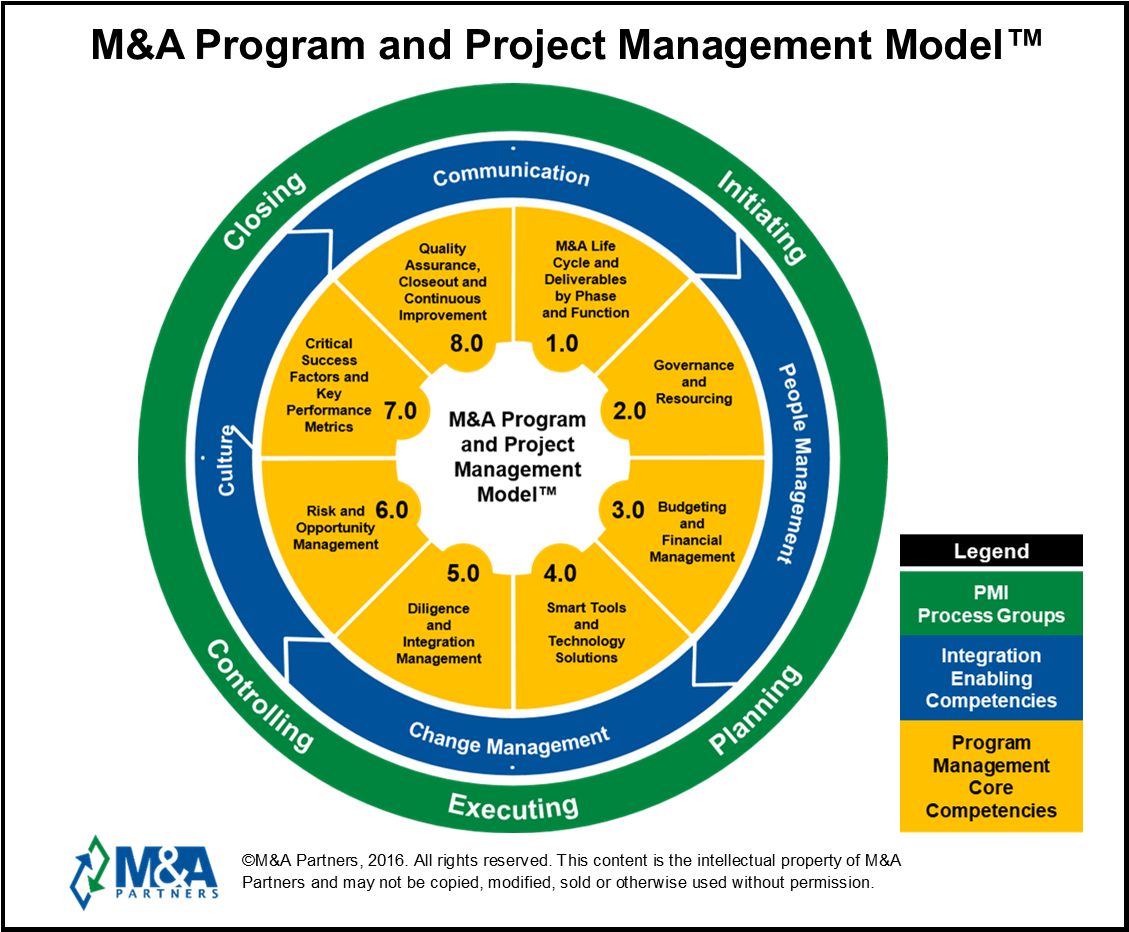A Modern Model of Competencies and Responsibilities
by Stephanie Snyder, Senior Partner at M&A Partners

That’s a question we get from a lot of organizations which are attempting to improve their M&A capabilities and develop their internal M&A resources. First, let’s talk about the differences between M&A Program Management and M&A Project Management. While both are essential to integration success, the roles and responsibilities of classic Program Managers and Project Managers are distinct.
Program Management: Broad and Strategic
Program Management, typically executed by a full-time, dedicated Integration Manager or Director, is responsible for oversight and coordination of the entire M&A program, including all the value driver and functional teams. In addition, M&A Program Managers are responsible for designing the overall integration plan to ensure that it delivers the full potential of the combination. They’re also responsible for developing an integration budget and resource model to estimate what the integration will cost and how long it will tie up key resources. They act as the “traffic cop” to set the pace and manage the cadence of integration activities. They also track and report integration progress to an oversight Steering Committee, Deal Sponsor, and/or CEO. In addition, they identify and manage key risks and develop mitigation plans, resolve cross-team issues in a timely manner, facilitate decision-making and manage conflict within the teams. Program Managers also serve as the primary ambassador to the target company and coordinate activities and communication across company lines. Finally, Program Managers must be masters of change and model leadership of the cultural attributes the integration is promoting. Therefore, the role of the classic Program Manager tends to be broader and more strategic.
Project Management: Narrow and Deep
Project Management, typically executed by professional Project Managers or Functional Team Leads, is responsible for the design and tactical execution of integration work plans. They ride herd on the hundreds of tasks that must be accomplished to bring the businesses and organizations together and ensure that the work is getting done on time and within budget. They coordinate actions, remove obstacles and execute their plans. Their classic role tends to be narrower, but deeper.
The Blending of Roles in Today’s Integration Management Office
What’s interesting is that in today’s fast-paced, demanding integration environment, the classic roles of Program Managers and Project Managers have begun to blend. There are several reasons for this. First of all, today’s deals are simply more complex. More and more often, companies are charging their Integration Management Offices with larger deals, international deals, transformational deals, and/or multiple simultaneous deals. This level of increased complexity is demanding more of both M&A Program and Project Managers. No longer is it enough to simply show up and do your job. Today’s mergers and acquisitions require super-hero strengths and competencies.
So, Once Again, What Does it take to be Great?
At M&A Partners, we’ve created the following model of the competencies we believe every modern M&A Program and Project Manager needs. We blended the model to include both Program and Project Managers because we believe the similarities between the roles are as important as the differences and primarily a matter of degree and focus.

For example, looking at the green outer circle of the model, Program Managers are likely to spend most of their time initiating, planning, controlling and closing the project. Project Managers, on the other hand, will spend most of their time executing. But that doesn’t mean Program Managers don’t have to worry about execution. Likewise, today’s Project Managers need to fully understand why the integration program has been designed and planned as it has and they need to fully participate in controlling and closing the program to ensure quality and continuous improvement.
Looking at the blue circle, Program Managers will spend a significant amount of their time and energy managing communication, people, change and culture. But Project Managers are not exempt from responsibility in any of these areas.
The orange shapes also represent shared responsibilities. While the primary role of the Project Manager will focus on 5.0 Diligence and Integration Management, they must certainly understand and participate in all of the remaining areas for the integration to meet its objectives.
Blended Roles – One Workshop
Because we are seeing a true blending of the roles of Program and Project Managers in today’s M&A environment, the M&A Leadership Council is offering a “deep dive” workshop titled, The Art of M&A Program Management. This course is designed to present more tactical, nuts-and-bolts information both Program and Project Managers need to execute a successful integration program. The course will provide the depth and tools needed by true practitioners. The course differs from standard Project Management training in that it focuses on what is unique and different about project management within a merger environment.
Join us for the next session of The Art of M&A for Program Management. See the program details for more information about the location, workshop curriculum and presenters.
The Future of M&A Program Management
At M&A Partners, we believe the success of complex mergers, acquisitions, joint ventures and divestitures is directly related to the capabilities of the integration resources tasked with executing them. Our mission is to help companies build their internal M&A capabilities and readiness to meet these new demands. For more information, contact us at mapartners.net.